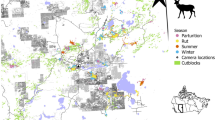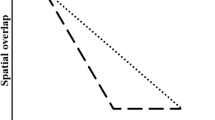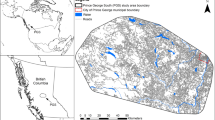Abstract
WE propose here a mechanism for territorial pattern formation in wolves (Canis lupus) and analyse it using a spatially explicit mathematical model incorporating wolf movement and scent marking. Model results reflect field observations from northeastern Minnesota: buffer zones where wolves are scarce arise between adjacent packs, and near these buffer zones there are increased levels of scent marking1,2. Territories are arranged in a spatial mosaic (Fig. 1) which covers the wolf range. In the model formulation no assumptions are made about actual existence or extent of wolf territory and buffer zones; these arise naturally as stable steady-state solutions to the equations. We show mathematically how reduced predation by wolves in the buffer zones provides a refuge for prey species. Field studies support this; distribution of a primary prey species, white-tailed deer (Odocoileus virginianus), correlates negatively with that of wolves. Deer are found primarily in buffer zones3,4 (Fig. 2).
This is a preview of subscription content, access via your institution
Access options
Subscribe to this journal
Receive 51 print issues and online access
$199.00 per year
only $3.90 per issue
Buy this article
- Purchase on Springer Link
- Instant access to full article PDF
Prices may be subject to local taxes which are calculated during checkout
Similar content being viewed by others
References
Mech, L. D. Technical report, US Forest Service Research Paper NC-97 (North Central Forest Experimental Station, St Paul, Minnesota, 1973).
Van Ballenberghe, V., Erickson, A. W. & Byman, D. Wildl. Mono. 43, 1–43 (1975).
Hoskinson, R. L. & Mech, L. D. J. Wildl. Manage. 40, 429–441 (1976).
Rogers, L. L., Mech, L. D., Deanna, K. D., Peek, J. & Korb, M. J. Wildl. Manage. 44, 253–258 (1980).
Peters, R. P. & Mech, L. D. Am. Sci. 63, 628–637 (1975).
Mech, D. L. The Way of The Wolf (Voyageur, Stillwater, Minnesota, 1991).
Merti-Millhollen, A. S., Goodman, P. A. & Klinghammer, E. Zoo Biol. 5, 7–20 (1986).
Mech, L. D. The Wolf: The Ecology and Behaviour of an Endangered Species (Natural History Press, Garden City, New York, 1970).
Peters, R. in The Behaviour and Ecology of Wolves (ed. Klinghammer, E.) 119–152 (Garland, New York, 1979).
Mech, L. D. Science 198, 320–321 (1977).
Hickerson, H. in Man, Culture and Animals: The Role of Animals in Human Ecological Adjustments (eds Leeds, A. & Vayd, A.) 43–65 (American Association for the Advancement of Science, Washington DC, 1965).
Author information
Authors and Affiliations
Rights and permissions
About this article
Cite this article
Lewis, M., Murray, J. Modelling territoriality and wolf–deer interactions. Nature 366, 738–740 (1993). https://doi.org/10.1038/366738a0
Received:
Accepted:
Issue Date:
DOI: https://doi.org/10.1038/366738a0
This article is cited by
-
Spatial memory predicts home range size and predation risk in pheasants
Nature Ecology & Evolution (2023)
-
Open problems in PDE models for knowledge-based animal movement via nonlocal perception and cognitive mapping
Journal of Mathematical Biology (2023)
-
Special Collection: Celebrating J.D. Murray’s Contributions to Mathematical Biology
Bulletin of Mathematical Biology (2022)
-
Prey and habitat distribution are not enough to explain predator habitat selection: addressing intraspecific interactions, behavioural state and time
Movement Ecology (2021)
-
White-tailed deer herbivory impacts on tree seedling and sapling abundance in the Lake States Region of the USA
Annals of Forest Science (2021)
Comments
By submitting a comment you agree to abide by our Terms and Community Guidelines. If you find something abusive or that does not comply with our terms or guidelines please flag it as inappropriate.



